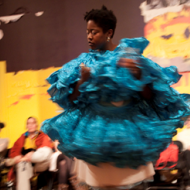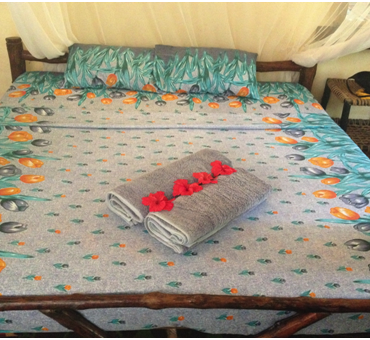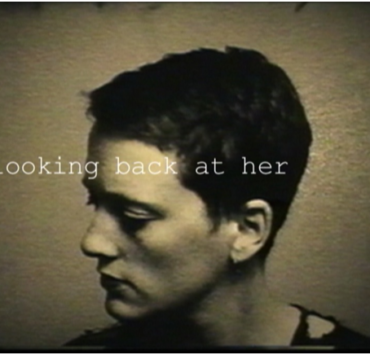
This performance was an excerpt from a longer performance of “Aide-Mémoire”
premiered at the AfiRIperFOMA Biennial in Harare, Zimbabwe in November 2014,
remixed for “Girls in Their Bedrooms” in Minneapolis.
While the African version emphasized issues of cultural theft and re-appropriation (and included a large riff on Tom’s shoes), this version emphasized intimacy and community exchange.
For each performance, I selected personal objects of sentimental value
to circulate, discuss and exchange with audience members.
The objects included:
a palm-sized, a bird clip with glued on feathers, Mexican candles of saints, Sharon Patricia Holland’s scholarly book The Erotic Life of Racism, Slavenka Drakulic’s novel Frida’s Bed, a Haitian doll from childhood, a Haitian figurine, a sequined bottle, balloons and other idiosyncratic, lovely things . . .
The performance begins with the memory of a song:
“raindrops on roses / and whiskers on kittens
bright copper kettles / and warm woolen mittens
brown paper packages / tied up with strings
these are a few of my favorite things . . .”
As I sing, I offer these objects to members of the audience, allowing them to hold them in their hand. I invite them to move them throughout the crowd, letting their hands hold the objects, inviting them to pass them along, to let them go . . .
And I chant: And this is my memories moving, And this is my memories moving
And this is my memories moving, And this is my memories moving
While chanting, the objects would move through the space.
When I stopped, I would lower my hands, and the objects would still themselves
in the hands or laps of where they were.
Then moving the language through my body, I told this story:
My cousin Mona always said she would SHOW HER NO GOOD EX-HUSBAND.
He couldn’t just leave her like a low-class peasant girl for some fancy woman.
Although that’s exactly what he did. And I know because my cousin Mona was married
to my father’s best friend. But that didn’t matter because when he left, she went off to
New York City and worked for the wealthy Venezuelan people in a house bigger
than I’d ever seen. And when I went to visit her in New York City when I was 14 years old,
I was AMAZED. In their tony townhouse by the East River, they had an elevator.
And instead of wallpaper, they had roses painted on the walls. And they even had a gen-u-ine Monet painting which hardly anyone ever saw except for the butler and the maid and my cousin Mona because the wealthy Venezuelan people only came to that house once or twice a year.
And they loved my cousin Mona—that’s what she said—and they would take her to their house in Caracas, and to Paris and to London and they would shower her with gifts and give her things and you would think that she was doing fine . . . That she had moved on and had made it and wouldn’t care what her NO GOOD EX-HUSBAND would think. But NO. My cousin Mona had a problem. Even as she had managed to get so far away, she couldn’t forget. And so she went back to Haiti, and she built a huge house full of fancy shoes, and pit bull protection—the neighbors wondered, who was this fancy woman? Was she a drug dealer? A drug dealer’s woman—and she was surrounded by precious, beautiful objects.
It cracks—
I look at the audience and start to scream these words:
GIVE THEM BACK TO ME
GIVE ME BACK MY MEMORIES
GIVE ME BACK TO ME
I look at the audience and summon forth the objects that I gave to them
that circulated through the crowd. I call them by name:
GIVE ME BACK MY DOLL!
I NEED MY DOLL! GIVE ME BACK MY DOLL!
I HAVE TO HAVE MY DOLL
I CAN’T SLEEP WITHOUT MY DOLL
GIVE IT BACK TO ME
GIVE ME BACK MY MEMORIES
GIVE ME BACK TO ME
And a person in the audience would come and give it back to me
and I would lay it before me in a line. . . .
GIVE ME BACK MY BIRD!
GIVE IT BACK! GIVE ME BACK MY BIRD!
I NEED MY BIRD FOR FLIGHT
I NEED MY BIRD FOR CHIRPING
I NEED MY BIRD FOR MORNING BIRDSONG
GIVE IT BACK TO ME
GIVE ME BACK MY MEMORIES
GIVE ME BACK TO ME
And another person in the audience would come and give it back to me
and I would lay that object next to the first one/ before me in a line. . . .
GIVE ME BACK MY EROTIC LIFE OF RACISM!
GIVE IT BACK! GIVE IT BACK TO ME!
I NEED MY EROTIC LIFE OF RACISM TO UNDERSTAND THIS WORLD
I NEED MY EROTIC LIFE—THE RACISM NOT SO MUCH
BUT THE EROTIC LIFE OF RACISM IS MINE
GIVE IT BACK TO ME
GIVE ME BACK MY MEMORIES
GIVE ME BACK TO ME
And each night the chant was different, because the objects were different
and the people were different and they would come forward
and by the end there would be a beautiful line of things . . . .
And once all the objects were there, I would pick up each one
and consider it and say:
And this is my memory
And this is my memorial
And this is my treachery
And this is my keepsake
And this is my déjà vu
And this my gift
And this is my aide-mémoire
And this is now for you
And then I would say:
Let’s change things. I mean let’s exchange it.
What if this were all different?
I mean what if this object, this object of memory
of mine could be changed for an object, a memory of you?
And each night, I would give the provenance of each object
Let me tell you about these things. . .
This bird—it’s a relatively new thing but I love it. I bought it outside of Oakland at the dollar store with my friends Marco and Daffodil and their sweet baby daughter Suleya, well not a baby anymore, a titanic two! And I know the dollar store isn’t great—I mean who knows the work conditions where all that cheap stuff is made—but I loved it because there were all these black and brown people gathering to get party decorations and we were looking at beads and plates and plastic swords and there was this little fake bird with a clip and I immediately put it into my hair because who doesn’t want a little bird in their hair and it’s new—I mean I just got it a couple months ago, but I love it and it’s a memory and I want to exchange for a memory from someone else. Who wants the bird?
And there was competition in the crowd . . .
And people had to work it out with storytelling and sharing . . .
This book—The Erotic Life of Racism. I heard about it on the job interview for my new job. And it opens with a powerful memory of the writer talking about Tupac’s murder and sitting in a car with her niece in a grocery story—if I remember this right—and there was an angry white woman who wanted them to interrupt their conversation, this moment of connection which the white woman didn’t even see because she wanted to get a grocery cart and so there’s analysis of this moment that reaches out into critical race theory and queer theory and the whole crazy world of murder and grief and disconnection and it’s an academic book but it’s talking about very real things. So this isn’t charity—or foreign aid—or even an object of discussion. This is a real thing. Who wants the book? What will you exchange?
And my friend Miré called out and traded it for a silver spoon.
This doll. Now this is an old doll, something my father brought back from Haiti
when I was young. It’s something that connected me to a place that belonged to me
but where I had never been. It makes me think of my grandmother and my cousins
and my aunt and yes cousin Mona and I brought it here in preparation for another performance I’m making in Montréal. So this is a part of past memory and future memory to be made and the memory we are making right now. Who wants the doll? What object, what memory can you offer? What gift economy?

And so on . . .
And once all the exchanges had happened
And the objects were there and gone,
I sang again:
“raindrops on roses / and whiskers on kittens
bright copper kettles / and warm woolen mittens
brown paper packages / tied up with strings
these are a few of my favorite things . . .
when the dog bites / when the bee stings
when I’m feeling sad . . .
I simply remember my favorite things
and then I don’t feel . . .
and then I don’t feel . . .
and then I don’t feel . . .
And this is my memories moving, And this is my memories moving
And this is my memories moving, And this is my memories moving
And this is my memories moving . . .
FIN.

Gabrielle Civil is a black feminist poet, conceptual and performance artist, originally from Detroit, MI. In summer 2014 she premiered “_____ is the thing with feathers” and reprised “Say My Name” (an action for 270 abducted Nigerian girls) at “Call & Response,” an innovative two-part festival of black women and performance that she organized at Antioch College. Other recent work includes: “Fugue (Da, Montréal)” at the Hemispheric Institute Encuentro in Montreal, Canada (June 2014); “Aide-mémoire,” at the AFiRiperFOMA Biennial in Harare, Zimbabwe (Nov. 2013); and a restaging of John Cage’s “How to Get Started.” Gabrielle is currently circulating Swallow the Fish, her critical/creative text on black feminist performance art practice. She is Associate Professor of Performance at Antioch College in Yellow Springs, OH. The aim of her work is to open up space. www.gabriellecivil.com







